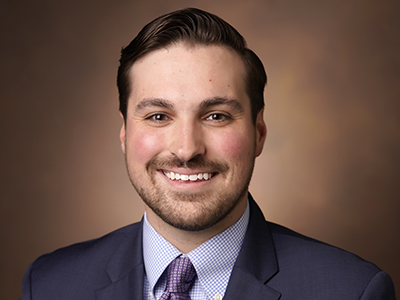 UAB Department of Neurosurgery PGY1 Resident Andrew Hale, M.D., Ph.D., was awarded a $25,000 grant from The Aneurysm and AVM Foundation (TAAF) for his study titled "Multi-omics analysis elucidates the genetic basis of Vein of Galen Malformation."
UAB Department of Neurosurgery PGY1 Resident Andrew Hale, M.D., Ph.D., was awarded a $25,000 grant from The Aneurysm and AVM Foundation (TAAF) for his study titled "Multi-omics analysis elucidates the genetic basis of Vein of Galen Malformation."
Vein of Galen aneurysmal malformations (VGAMs) are among the most common and severe neonatal blood vessel anomalies of the human cerebral vasculature. VGAM are the result of abnormal connections between arteries, veins, and capillary vessels during neonatal development.
Even with neurosurgical intervention, VGAM can cause systemic problems such as cardiac failure due to the heart’s inability to accommodate the largest amount of blood flow into the venous system.
The VGAM may also cause increased intracranial pressure, leading to brain hemorrhage or impaired draining of cerebrospinal fluid resulting in hydrocephalus (i.e., accumulation of cerebrospinal fluid in the brain). These problems may be life-threatening. Despite this, the cause of VGAM is largely unknown but is widely hypothesized to be caused by genetic abnormalities.
Hale’s study aims to understand the genetic and molecular basis of VGAM by utilizing human genetics and functional genomics approaches combining cutting-edge, next-generation whole-genome sequencing and single-cell RNA sequencing of cells obtained during surgical treatment of VGAM to characterize the mutational and gene-expression landscape.
Hale will be the first to perform a genetic analysis of VGAM tissue directly.
The study cohort is largely comprised of individuals with African ancestry with the hope of reducing long-standing disparities in genetics studies. Understanding the genetic basis of VGAM may broadly inform the understanding of cerebrovascular development and disease pathogenesis, improve clinical prognostication and decision-making, and provide a mechanistic foundation for the rationale use of repurposed drugs and/or design of targeted therapeutics relevant for VGAM and potentially other cerebrovascular lesions.
"I am incredibly honored to receive funding for our work to delineate the genetic basis of VGAM from The Aneurysm and AVM Foundation and the UAB Center for Clinical and Translational Science,” said Hale. “Our study will elucidate the fundamental genetic etiology and aberrations underlying VGAM with the goal of identifying targets for therapeutic intervention. I am grateful to these funding agencies, Dr. Jesse Jones for his mentorship on this project, and to the faculty and staff within the Division of Pediatric Neurosurgery at Children's of Alabama for their support."